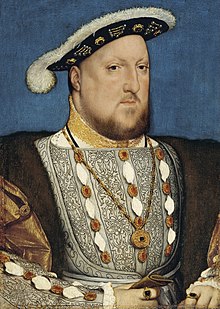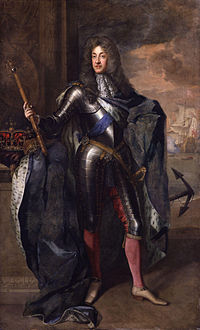History of Ireland (1536–1691)
This article has multiple issues. Please help improve it or discuss these issues on the talk page. (Learn how and when to remove these template messages)
|
| History of Ireland |
|---|
 |
|
t |
Ireland during the period of 1536–1691 saw the first full conquest of the island by
The
Re-conquest and rebellion (1536–1607)

King of England and Ireland, who founded the Kingdom of Ireland and began the English re-conquest of the country, by Hans Holbein the Younger
There is some debate about why Henry VIII of England resolved to re-conquer Ireland completely. However, the most immediate reason was that the Fitzgerald dynasty of
Ireland was changed from a lordship to a full Kingdom under Henry VIII. From the period of the original lordship in the 12th century onwards, Ireland had retained its own bicameral
With the institutions of government in place, the next step was to extend the control of the English Kingdom of Ireland over all of its claimed territory. Henry VIII's officials were tasked with extending the rule of this new Kingdom throughout Ireland by the policy of "surrender and regrant". They either negotiated or fought with the autonomous Irish Kings and lords. This took nearly a century to achieve, and the re-conquest was accompanied by a great deal of bloodshed, as it led to the assimilation – sometimes abolition – of lordships that had been independent for several hundred years.

The re-conquest was completed during the reigns of
Colonization and the religious question
The English had little success in converting either the native elite or the Irish people to the Protestant religion. Why the
From the mid-16th and into the early 17th century, crown governments carried out a policy of colonisation known as
These settlers, who had a British and Protestant identity, would form the ruling class of future British administrations in Ireland. A series of
A New Order? (1607–1641)
The difficulty in controlling the extremities of Ireland from London or Dublin early in the 17th century was demonstrated by the presence of
In the early years of the 17th century, it looked possible for a time that, because of immigration of English and Scottish settlers, Ireland could be peacefully integrated into British society. However, this was prevented by the continued discrimination by the English authorities against Irish Catholics on religious grounds.
The pre-Elizabethan Irish population is usually divided into the "Old (or
Most of the Irish upper classes, however, were not ideologically opposed to the sovereignty of the King of England over Ireland, but wanted to be full subjects of the triple Stuart monarchy and maintain their pre-eminent position in Irish society. This was prevented by their religious dissidence and the threat posed to them by the extension of the Plantations. The Protestant settler-dominated Government of Ireland tried to confiscate more land from the native landowners by questioning their medieval land titles and as punishment for non-attendance at Protestant services. In response, Irish Catholics appealed directly to the King, first to James I and then Charles I, for full rights as subjects and toleration of their religion: a programme known as The Graces. On several occasions, the Monarchs appeared to have reached an agreement with them, granting their demands in return for raising taxes. However, Irish Catholics were disappointed when, on paying the increased levies, the King postponed the implementation of their demands. What was more, by the late 1630s, Thomas Wentworth, Charles's representative in Ireland, was proposing further widespread confiscations of native land to break the power of the Irish Catholic upper classes. It is likely that this would eventually have provoked armed resistance from Irish Catholics at some point, but the actual rebellion was sparked by a political crisis in Scotland and England that led to civil war in the three Kingdoms.
Civil wars, Land confiscations and Penal Laws (1641–1691)

The fifty years from 1641 to 1691 saw two catastrophic periods of civil war in Ireland 1641–53 and 1689–91, which killed hundreds of thousands of people and left others in permanent exile. The wars, which pitted Irish Catholics against British forces and Protestant settlers, ended in the almost complete dispossession of the Catholic landed elite.
The Confederate War and Cromwellian conquest
In the mid-17th century, Ireland was convulsed by
The rebellion was marked by a number of massacres of Protestant settlers, particularly in Ulster, an event which scarred communal relations in Ireland for centuries afterwards.
As a result of the outbreak of the
As punishment for the rebellion of 1641, almost all lands owned by Irish Catholics were confiscated and
Restoration
An uneasy peace returned with the

Irish Catholics, known as Jacobites, fought for James in 1689–91, but they failed to restore him to the throne of Ireland, England and Scotland
The War of the Two Kings
However, within a generation of the Restoration, Ireland was at war again. In the reign of the Catholic King James II of England, Irish Catholics briefly looked like recovering their pre-eminent position in Irish society. James repealed much of the anti-Catholic legislation, allowed Catholics into the Irish Parliament and the Army and appointed a Catholic, Richard Talbot, 1st Earl of Tyrconnell, as Lord Deputy of Ireland. Protestants in Ireland could do little about this turn of events.
However, with the
The same year
Protestant Ascendancy
In addition, as of 1704, Presbyterians were also barred from holding public office, bearing arms and entering certain professions. This was in part due to the distrust the mostly English Anglican establishment had for the mostly Scottish Presbyterian community, which by now had become a majority in Ulster. By the end of the 17th century, Ireland's population was about 25% Protestant (including all denominations) of whom Anglicans (about 13%) formed the ruling Protestant Ascendancy. For the 18th century see
See also
- Early Modern Irish language
- Irish of Nantes
Sources
- Canny, Nicholas P (May 1976). The Elizabethan Conquest of Ireland: A Pattern Established, 1565–76. Sussex: Harvester Press Ltd. ISBN 0-85527-034-9.
- Canny, Nicholas P (3 May 2001). Making Ireland British, 1580–1650. Oxford University Press. ISBN 0-19-820091-9.
- Hayes-McCoy, Gerard Anthony (June 1989). Irish Battles. Belfast: Appletree Press. ISBN 0-86281-212-7.
- Lenihan, Pádraig (2003). 1690: Battle of the Boyne. Tempus. ISBN 0-75243-304-0.
- Lenihan, Pádraig (2001). Confederate Catholics at War 1641–49. Cork University Press. ISBN 1-85918-244-5.
- Lennon, Colm (March 1995). Sixteenth Century Ireland – The Incomplete Conquest. Dublin: St. Martin's Press. ISBN 0-312-12462-7.
- Moody, T. W.; Martin, Francis X.; Byrne, F. J. (1991). A new history of Ireland: Early modern Ireland, 1534–1691. Oxford University Press. ISBN 978-0-19-820242-4.
 O'Brien, Richard Barry, ed. (1903). . Dublin: Browne and Nolan, Ltd. – via Wikisource.
O'Brien, Richard Barry, ed. (1903). . Dublin: Browne and Nolan, Ltd. – via Wikisource.- Ó Siochrú, Micheál (1999). Confederate Ireland 1642–49. Dublin: Four Courts Press. ISBN 1-85182-400-6.
- Kenyon, J.; Ohlmeyer, J. H. (1998). The Civil Wars: A Military History of England, Scotland and Ireland, 1638–1660. Oxford University Press. ISBN 0-19280-278-X.
- Senior, Clive M. (1976). A Nation of Pirates. ISBN 0-7153-7264-5.
- Simms, J.G. (1969). Jacobite Ireland. Routledge & Kegan Paul, Limited. ISBN 0-71006-446-2.
- Simms, J.G. (1986). War and Politics in Ireland 1649–1730. Continuum International. ISBN 0826436099.
- Waudchope, Piers (1992). Patrick Sarsfield and the Williamite War. Dublin: Irish Academic Press. ISBN 0-71652-476-7.
- Wheeler, James Scott (1999). Cromwell in Ireland. St. Martin's Press. ISBN 0-31222-550-4.
External links
- 16th century images of Irish people at Irish Archaeology
- Tudor and Stuart Ireland, annual academic conference focusing on Irish society in the Tudor and Stuart periods.
- ^ Senior 1976, pp. 41, 68.
- ^ Senior 1976, pp. 53–57.
- ^ Senior 1976, p. 54.

